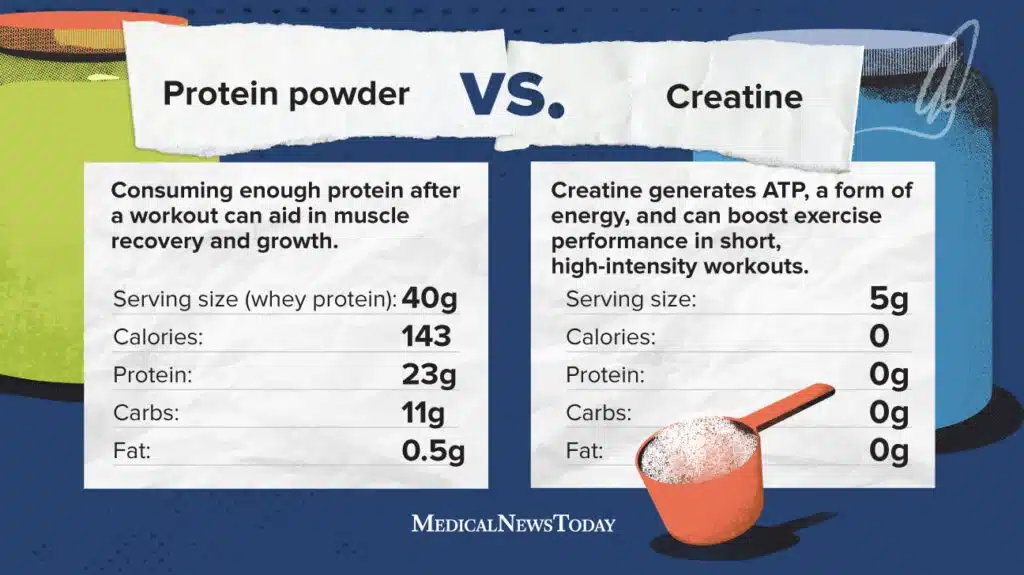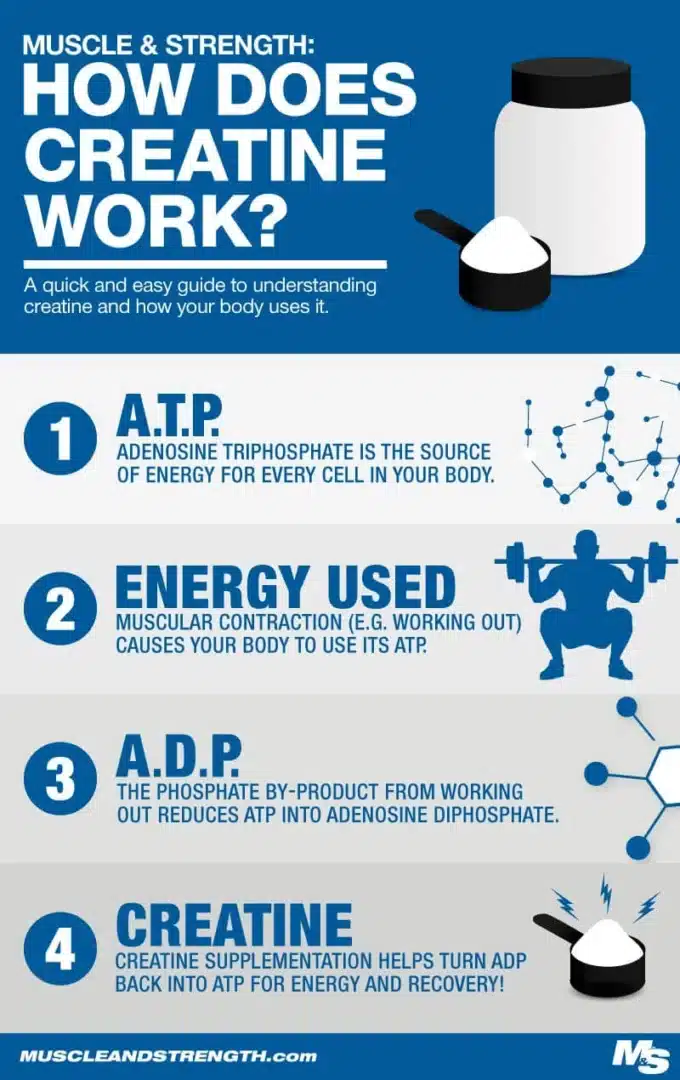Creatine for CrossFit isn’t just a supplement; it’s a game-changer. Whether you’re pushing through intense WODs or striving for new personal records, Creatine for CrossFit can significantly enhance your strength, endurance, and recovery. In this comprehensive guide, we’ll break down how Creatine for CrossFit can elevate your performance, the best strategies for usage, and debunk common myths.
Table of Contents
What is Creatine?
Creatine is a naturally occurring amino acid found in muscle cells. It helps your muscles produce energy during high-intensity exercise, which is why it’s so effective for CrossFit athletes. Creatine for CrossFit boosts muscle strength and improves recovery, making it one of the most popular supplements in functional fitness.
Key Benefits of Creatine for CrossFit Athletes
- Increased Muscle Power: With Creatine for CrossFit, you’ll experience a surge in explosive power, perfect for lifting heavier weights and performing sprints.
- Faster Recovery: Reduce muscle soreness and bounce back faster after intense WODs, allowing you to train more consistently.
- Enhanced Endurance: CrossFit demands stamina, and creatine helps maintain your energy levels during longer workouts.
- Improved Performance: Athletes using Creatine for CrossFit often report improvements in their ability to push through plateaus and hit new PRs.
How to Use Creatine for CrossFit Effectively

When incorporating Creatine for CrossFit into your routine, there are specific strategies that maximize its benefits. Here’s how you can use it to supercharge your workouts:
- Dosage: A standard daily dose is 3-5 grams of creatine monohydrate.
- Timing: Take creatine post-workout or with meals for optimal absorption.
- Hydration: Drink plenty of water throughout the day, as creatine pulls water into your muscles.
The Science Behind Creatine for CrossFit
Creatine enhances your body’s ability to produce adenosine triphosphate (ATP), which is the energy currency used during short bursts of high-intensity exercise. This is why Creatine for CrossFit is especially beneficial—it helps you power through explosive movements like deadlifts, box jumps, and sprints with increased intensity.
Creatine Loading Phase: Is It Necessary?
The loading phase involves taking higher doses of creatine (around 20 grams per day) for 5-7 days to saturate your muscle stores quickly. After that, you transition into the maintenance phase with a daily dose of 3-5 grams. While loading is not strictly necessary, it can help you see results faster.
Creatine Maintenance Phase: Sustaining Your Gains
Once you’ve completed the loading phase, maintaining your creatine levels with a daily dose of 3-5 grams is essential to keep reaping the performance benefits. Consistency is key when using Creatine for CrossFit.
Cycling Creatine: Should You Do It?
Some athletes choose to cycle creatine, typically using it for 8 weeks followed by a 4-week break. However, research shows that long-term creatine use is safe, and cycling isn’t necessary unless you prefer to take breaks for personal reasons.
Creatine FAQs for CrossFitters
Q1: Does creatine cause water retention?
Yes, creatine pulls water into your muscle cells, but this leads to increased muscle volume, not bloating. For CrossFitters, this is beneficial for muscle performance.
Q2: Should I take creatine every day?
Yes, even on rest days. Consistent intake ensures your muscles stay saturated with creatine.
Q3: Can creatine help with weight loss?
Creatine itself doesn’t burn fat, but it supports lean muscle growth, which can improve your body composition over time.
Q4: Is creatine safe?
Yes, creatine is one of the most researched supplements and is safe for healthy individuals when taken as recommended. Always consult a healthcare provider if you have pre-existing medical conditions.
Combining Creatine with Other Supplements for Maximum Impact
Creatine works well with other supplements to enhance its effects. Here are some powerful combinations for CrossFit athletes:
- Creatine and Beta-Alanine: Beta-alanine helps buffer lactic acid, reducing muscle fatigue during high-rep workouts. Paired with creatine, it supports endurance and strength.
- Creatine and Protein: Post-workout protein shakes with creatine improve muscle recovery and growth.
- Creatine and Caffeine: Some studies suggest taking caffeine and creatine at separate times due to potential interaction, but both can enhance performance.
Dietary Considerations for Creatine Supplementation
While creatine supplementation is the most effective way to increase your levels, you can also get small amounts from food sources like red meat and fish. However, vegetarians and vegans typically have lower baseline creatine levels, making supplementation even more beneficial.
Practical Tips for Creatine Supplementation
- Stay Hydrated: Creatine pulls water into your muscles, so staying hydrated is essential.
- Be Consistent: Take creatine every day, even on rest days.
- Monitor Your Body: If you experience any side effects like bloating or stomach discomfort, try splitting your dose throughout the day.
Myths and Misconceptions about Creatine
- Myth 1: Creatine is a steroid
Truth: Creatine is a naturally occurring compound, not a steroid. - Myth 2: Creatine causes kidney damage
Truth: Creatine is safe for healthy individuals. Those with pre-existing kidney issues should consult a doctor. - Myth 3: Creatine leads to bloating
Truth: Creatine increases water content in muscles, leading to enhanced performance without noticeable bloating.
Conclusion: Why Every CrossFit Athlete Should Consider Creatine

Incorporating Creatine for CrossFit into your training regimen can be a game-changer for your performance. Whether you’re looking to increase strength, improve endurance, or recover faster, creatine offers numerous benefits that make it a staple supplement for CrossFit athletes. By following the best usage strategies and staying consistent, you’ll maximize your gains and achieve new personal bests.
For more insights on CrossFit supplements and performance, check out resources like CrossFit Journal, WODwell, and Rogue Fitness.
FAQ Section
Q1: How long does it take to see results from creatine?
Results typically become noticeable within 1-2 weeks, especially if you go through a loading phase.
Q2: Can I take creatine with pre-workout?
Yes, creatine can be taken with most pre-workout supplements, though it’s best to monitor your body’s response.
Q3: Should I cycle off creatine?
Cycling is optional, but current research supports continuous use without the need for breaks.
Q4: Is creatine suitable for beginners in CrossFit?
Absolutely! Creatine is beneficial for athletes at all levels, from beginners to experienced CrossFitters.
Creatine and CrossFit Performance: Real-World Benefits for Athletes
One of the most compelling reasons to incorporate Creatine for CrossFit into your routine is the real-world performance benefits that athletes experience. While studies support the effectiveness of creatine, hearing about its impact directly from those who use it in their training helps to highlight its value.
Enhanced Strength for High-Rep Lifting
CrossFit demands not only endurance but also the ability to handle heavy weights at high repetitions. Whether you’re performing deadlifts, cleans, or thrusters, Creatine for CrossFit helps athletes push through multiple sets with less fatigue. Athletes consistently report improved strength and the ability to lift heavier for longer periods, which can lead to breaking personal records faster than before.
Example: After four weeks of consistent creatine supplementation, athletes noticed improvements in their one-rep maxes and increased work capacity during high-rep barbell complexes.
Improved Sprint and Power Output in WODs
Creatine is particularly effective in boosting short-term, high-intensity efforts, such as sprints and explosive movements. During a typical WOD that involves running, rowing, or sprinting between other functional movements, athletes find that creatine provides an extra edge in maintaining speed across rounds.
Example: Athletes using Creatine for CrossFit frequently report that they are able to maintain faster sprint times across multiple rounds of a WOD, which directly translates to improved overall performance and ranking in competitive settings.
Faster Recovery Between Workouts

CrossFit often involves multiple intense workouts per week, leaving athletes with little time for recovery. This is where creatine shines. By reducing muscle soreness and speeding up muscle repair, Creatine for CrossFit enables athletes to return to their next workout with full energy and reduced soreness, even after the most grueling sessions.
Example: CrossFit athletes have found that after incorporating creatine, they recover faster between heavy lifting days or back-to-back WODs, helping them train more consistently without needing as many rest days.
Delaying Fatigue During Long Workouts
One of the challenges CrossFit athletes face is managing fatigue during long, intense workouts. Whether it’s a Hero WOD or a high-volume session, staying energized and strong throughout is key to performance. Creatine for CrossFit helps delay the onset of fatigue by supporting ATP production, giving athletes more stamina for longer WODs.
Example: Athletes note that their energy levels remain higher for longer, allowing them to finish strong in 20-30 minute WODs without significant drops in performance.
How Different CrossFit Athletes Can Maximize Results with Creatine
While Creatine for CrossFit offers significant performance benefits across the board, it’s essential to tailor your approach based on your fitness goals and athletic level. Whether you’re a beginner, intermediate, or advanced CrossFit athlete, understanding how to adjust your creatine supplementation can maximize your results.
Creatine for Beginners in CrossFit: Building a Solid Foundation
For those new to CrossFit, building strength and endurance is key to progressing through the demanding WODs. Creatine for CrossFit beginners provides a fast track to achieving early strength gains and increasing stamina.
How Beginners Should Use Creatine:
- Start with a Loading Phase: While it’s not mandatory, beginners can benefit from a loading phase (20 grams daily for 5-7 days) to quickly saturate their muscles with creatine. This ensures that the performance benefits kick in faster.
- Daily Maintenance Dose: After the loading phase, transition to a daily dose of 3-5 grams. Consistency is vital, as missing doses will reduce the long-term effectiveness of creatine supplementation.
- Focus on Strength Gains: Beginners will notice substantial improvements in their ability to lift heavier weights as creatine supports ATP production. This helps build foundational strength in key lifts like deadlifts, squats, and overhead presses.
Benefits for Beginners: Beginners using Creatine for CrossFit often experience faster strength gains, reduced muscle soreness after intense WODs, and increased ability to perform high-rep sets, which accelerates their overall progress.
Creatine for Intermediate CrossFit Athletes: Breaking Through Plateaus
For intermediate athletes who have been training consistently but feel like they’ve hit a plateau, Creatine for CrossFitcan be the catalyst to push past these sticking points. At this stage, athletes are often looking to improve their performance on technical lifts, endurance in long WODs, and recovery between workouts.
How Intermediate Athletes Should Use Creatine:
- Focus on Consistent Dosing: Intermediate athletes should maintain a consistent 3-5 grams per day, with no need to return to a loading phase unless significant training changes occur (such as preparing for a competition).
- Pair Creatine with Strength Cycles: Intermediate athletes typically follow more structured training cycles, like strength blocks or hypertrophy phases. Creatine enhances the effects of these cycles by improving your ability to perform at maximum intensity during lifts.
- Combine Creatine with a Recovery Strategy: Since intermediate athletes often train 5-6 times a week, recovery becomes more critical. Combining creatine with a recovery-focused diet, proper hydration, and mobility work can help sustain performance levels and reduce the risk of overtraining.
Benefits for Intermediate Athletes: Intermediate CrossFitters using Creatine for CrossFit will see improvements in their ability to increase volume in their lifts, reduce fatigue during long AMRAPs, and recover faster between intense training sessions. This allows them to make steady progress and break through previous performance plateaus.
Creatine for Advanced CrossFit Athletes: Fine-Tuning Performance
For advanced CrossFit athletes, the focus shifts to refining performance and competing at a higher level. At this stage, small gains in strength, endurance, and recovery can make a massive difference in competition outcomes. Creatine for CrossFit helps advanced athletes maintain peak performance during long and demanding training cycles while preparing for competitions.
How Advanced Athletes Should Use Creatine:
- Sustainability Over Time: Advanced athletes don’t need a loading phase since their creatine stores are likely already saturated. Maintaining a consistent daily dose of 5 grams ensures muscle creatine levels stay optimized for long-term training.
- Periodize Your Supplementation: Advanced athletes can periodize creatine supplementation to coincide with competition cycles. For example, athletes can focus on creatine supplementation during strength-building blocks or when preparing for competition peaks, ensuring their muscles are primed for maximum output during key workouts.
- Combine with Other Supplements: Advanced athletes often use a stack of supplements to boost their performance. Combining Creatine for CrossFit with beta-alanine for improved endurance or branched-chain amino acids (BCAAs) for muscle recovery can help maintain a competitive edge.
Benefits for Advanced Athletes: For advanced CrossFit athletes, Creatine for CrossFit helps sustain peak power output during Olympic lifts, high-rep gymnastics movements, and endurance-based WODs. Additionally, creatine supports faster recovery between competitive training sessions, allowing athletes to maintain a higher volume of intense training while minimizing fatigue.
Tailoring Creatine Use Based on Your CrossFit Goals

One of the greatest advantages of Creatine for CrossFit is its versatility, making it suitable for athletes with different training goals. Whether you’re focused on strength, endurance, or both, creatine can be adapted to support your unique CrossFit objectives.
Strength-Focused Athletes
CrossFitters who prioritize strength, particularly in powerlifting or Olympic lifts, will find creatine especially beneficial. For these athletes, the ability to lift heavier weights, perform more reps at higher percentages, and recover quickly between sets is crucial for ongoing progress.
How to Maximize Creatine for Strength:
- Take Creatine Post-Workout: Ensure you’re taking creatine after your heavy lifting sessions to support muscle recovery and optimize strength gains.
- Use a Consistent Program: Pair creatine with a well-structured strength program, focusing on compound lifts like deadlifts, squats, and cleans. The added ATP production from creatine will allow you to perform more sets and reps at heavier weights.
Results to Expect: With consistent creatine use, strength-focused CrossFit athletes can expect faster gains in one-rep max lifts, improved muscle hypertrophy, and greater overall power output during strength WODs.
Endurance-Focused Athletes
CrossFit isn’t just about strength—it also demands serious endurance, especially for longer WODs or Hero WODs like “Murph.” For athletes who focus more on endurance, Creatine for CrossFit helps maintain high energy levels throughout long workouts and improves recovery time between rounds.
How to Maximize Creatine for Endurance:
- Take Creatine Before Longer Workouts: While creatine is typically most effective when taken post-workout, endurance-focused athletes may benefit from taking it pre-workout for longer WODs. This helps maintain energy levels during extended periods of physical exertion.
- Pair Creatine with Beta-Alanine: Beta-alanine is an amino acid that helps reduce muscle fatigue, making it an excellent complement to creatine for endurance-based athletes. Together, these supplements provide a more sustained energy output during long-duration workouts.
Results to Expect: For endurance-focused athletes, creatine helps maintain peak performance throughout high-volume WODs, sustain higher energy levels, and support faster recovery between intense intervals.
Athletes Focused on Recovery
Recovery is a critical component of CrossFit training, and Creatine for CrossFit is known for its ability to support muscle repair and reduce soreness. If your primary goal is recovery, creatine will help you get back to peak performance faster after each WOD.
How to Maximize Creatine for Recovery:
- Take Creatine Daily, Even on Rest Days: Consistent daily dosing is key for recovery-focused athletes. By taking creatine even on rest days, you’ll keep your muscles saturated with the energy they need to repair and rebuild.
- Hydrate Adequately: Since creatine pulls water into your muscles, staying hydrated is essential to maximize recovery. Pair creatine with at least 8-12 glasses of water per day, especially after intense WODs.
Results to Expect: With creatine supplementation, recovery-focused athletes can expect faster muscle repair, reduced soreness after high-intensity WODs, and an overall quicker return to full capacity for the next workout.
Conclusion: Finding Your Perfect Creatine Strategy
No matter what type of athlete you are—beginner, intermediate, or advanced—Creatine for CrossFit is a versatile and powerful supplement that can be tailored to meet your unique goals. Whether you’re chasing strength, endurance, or faster recovery, creatine offers tangible performance benefits that can elevate your training to the next level.
By incorporating creatine into your routine, staying consistent with dosing, and adapting it to your specific training needs, you’ll unlock new levels of performance and reach your CrossFit goals faster.
How Different CrossFit Athletes Can Maximize Results with Creatine
While Creatine for CrossFit offers significant performance benefits across the board, it’s essential to tailor your approach based on your fitness goals and athletic level. Whether you’re a beginner, intermediate, or advanced CrossFit athlete, understanding how to adjust your creatine supplementation can maximize your results.
Creatine for Beginners in CrossFit: Building a Solid Foundation
For those new to CrossFit, building strength and endurance is key to progressing through the demanding WODs. Creatine for CrossFit beginners provides a fast track to achieving early strength gains and increasing stamina.
How Beginners Should Use Creatine:
- Start with a Loading Phase: While it’s not mandatory, beginners can benefit from a loading phase (20 grams daily for 5-7 days) to quickly saturate their muscles with creatine. This ensures that the performance benefits kick in faster.
- Daily Maintenance Dose: After the loading phase, transition to a daily dose of 3-5 grams. Consistency is vital, as missing doses will reduce the long-term effectiveness of creatine supplementation.
- Focus on Strength Gains: Beginners will notice substantial improvements in their ability to lift heavier weights as creatine supports ATP production. This helps build foundational strength in key lifts like deadlifts, squats, and overhead presses.
Benefits for Beginners: Beginners using Creatine for CrossFit often experience faster strength gains, reduced muscle soreness after intense WODs, and increased ability to perform high-rep sets, which accelerates their overall progress.
Creatine for Intermediate CrossFit Athletes: Breaking Through Plateaus
For intermediate athletes who have been training consistently but feel like they’ve hit a plateau, Creatine for CrossFitcan be the catalyst to push past these sticking points. At this stage, athletes are often looking to improve their performance on technical lifts, endurance in long WODs, and recovery between workouts.
How Intermediate Athletes Should Use Creatine:
- Focus on Consistent Dosing: Intermediate athletes should maintain a consistent 3-5 grams per day, with no need to return to a loading phase unless significant training changes occur (such as preparing for a competition).
- Pair Creatine with Strength Cycles: Intermediate athletes typically follow more structured training cycles, like strength blocks or hypertrophy phases. Creatine enhances the effects of these cycles by improving your ability to perform at maximum intensity during lifts.
- Combine Creatine with a Recovery Strategy: Since intermediate athletes often train 5-6 times a week, recovery becomes more critical. Combining creatine with a recovery-focused diet, proper hydration, and mobility work can help sustain performance levels and reduce the risk of overtraining.
Benefits for Intermediate Athletes: Intermediate CrossFitters using Creatine for CrossFit will see improvements in their ability to increase volume in their lifts, reduce fatigue during long AMRAPs, and recover faster between intense training sessions. This allows them to make steady progress and break through previous performance plateaus.
Creatine for Advanced CrossFit Athletes: Fine-Tuning Performance
For advanced CrossFit athletes, the focus shifts to refining performance and competing at a higher level. At this stage, small gains in strength, endurance, and recovery can make a massive difference in competition outcomes. Creatine for CrossFit helps advanced athletes maintain peak performance during long and demanding training cycles while preparing for competitions.
How Advanced Athletes Should Use Creatine:
- Sustainability Over Time: Advanced athletes don’t need a loading phase since their creatine stores are likely already saturated. Maintaining a consistent daily dose of 5 grams ensures muscle creatine levels stay optimized for long-term training.
- Periodize Your Supplementation: Advanced athletes can periodize creatine supplementation to coincide with competition cycles. For example, athletes can focus on creatine supplementation during strength-building blocks or when preparing for competition peaks, ensuring their muscles are primed for maximum output during key workouts.
- Combine with Other Supplements: Advanced athletes often use a stack of supplements to boost their performance. Combining Creatine for CrossFit with beta-alanine for improved endurance or branched-chain amino acids (BCAAs) for muscle recovery can help maintain a competitive edge.
Benefits for Advanced Athletes: For advanced CrossFit athletes, Creatine for CrossFit helps sustain peak power output during Olympic lifts, high-rep gymnastics movements, and endurance-based WODs. Additionally, creatine supports faster recovery between competitive training sessions, allowing athletes to maintain a higher volume of intense training while minimizing fatigue.
Tailoring Creatine Use Based on Your CrossFit Goals
One of the greatest advantages of Creatine for CrossFit is its versatility, making it suitable for athletes with different training goals. Whether you’re focused on strength, endurance, or both, creatine can be adapted to support your unique CrossFit objectives.
Strength-Focused Athletes
CrossFitters who prioritize strength, particularly in powerlifting or Olympic lifts, will find creatine especially beneficial. For these athletes, the ability to lift heavier weights, perform more reps at higher percentages, and recover quickly between sets is crucial for ongoing progress.
How to Maximize Creatine for Strength:
- Take Creatine Post-Workout: Ensure you’re taking creatine after your heavy lifting sessions to support muscle recovery and optimize strength gains.
- Use a Consistent Program: Pair creatine with a well-structured strength program, focusing on compound lifts like deadlifts, squats, and cleans. The added ATP production from creatine will allow you to perform more sets and reps at heavier weights.
Results to Expect: With consistent creatine use, strength-focused CrossFit athletes can expect faster gains in one-rep max lifts, improved muscle hypertrophy, and greater overall power output during strength WODs.
Endurance-Focused Athletes
CrossFit isn’t just about strength—it also demands serious endurance, especially for longer WODs or Hero WODs like “Murph.” For athletes who focus more on endurance, Creatine for CrossFit helps maintain high energy levels throughout long workouts and improves recovery time between rounds.
How to Maximize Creatine for Endurance:
- Take Creatine Before Longer Workouts: While creatine is typically most effective when taken post-workout, endurance-focused athletes may benefit from taking it pre-workout for longer WODs. This helps maintain energy levels during extended periods of physical exertion.
- Pair Creatine with Beta-Alanine: Beta-alanine is an amino acid that helps reduce muscle fatigue, making it an excellent complement to creatine for endurance-based athletes. Together, these supplements provide a more sustained energy output during long-duration workouts.
Results to Expect: For endurance-focused athletes, creatine helps maintain peak performance throughout high-volume WODs, sustain higher energy levels, and support faster recovery between intense intervals.
Athletes Focused on Recovery
Recovery is a critical component of CrossFit training, and Creatine for CrossFit is known for its ability to support muscle repair and reduce soreness. If your primary goal is recovery, creatine will help you get back to peak performance faster after each WOD.
How to Maximize Creatine for Recovery:
- Take Creatine Daily, Even on Rest Days: Consistent daily dosing is key for recovery-focused athletes. By taking creatine even on rest days, you’ll keep your muscles saturated with the energy they need to repair and rebuild.
- Hydrate Adequately: Since creatine pulls water into your muscles, staying hydrated is essential to maximize recovery. Pair creatine with at least 8-12 glasses of water per day, especially after intense WODs.
Results to Expect: With creatine supplementation, recovery-focused athletes can expect faster muscle repair, reduced soreness after high-intensity WODs, and an overall quicker return to full capacity for the next workout.
Conclusion: Finding Your Perfect Creatine Strategy
No matter what type of athlete you are—beginner, intermediate, or advanced—Creatine for CrossFit is a versatile and powerful supplement that can be tailored to meet your unique goals. Whether you’re chasing strength, endurance, or faster recovery, creatine offers tangible performance benefits that can elevate your training to the next level.
By incorporating creatine into your routine, staying consistent with dosing, and adapting it to your specific training needs, you’ll unlock new levels of performance and reach your CrossFit goals faster.
For more tips and guides on optimizing your CrossFit training and supplement strategy, check out our blog and explore resources like Rogue Fitness and CrossFit Official.
Internal Link:
For more tips on optimizing your CrossFit training and supplement strategy, visit our blog.



